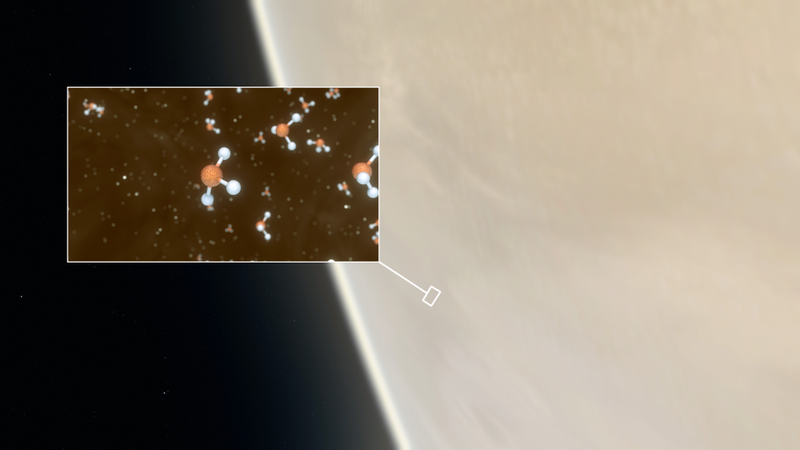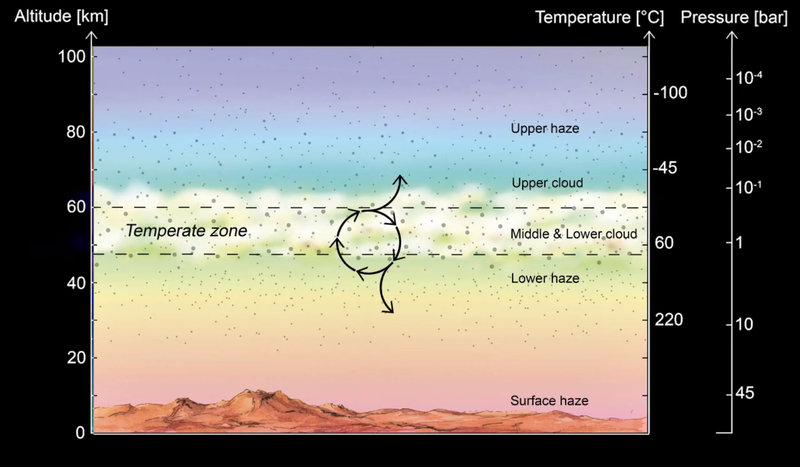
Scientists Detect Apparent Signature of Life in Venus’s Atmosphere
by George DvorskyIn a major announcement, a team of scientists is claiming to have detected trace amounts of phosphine in the atmosphere of Venus. It’s a bizarre and potentially monumental finding, as living organisms are the only known source of this stinky, toxic gas.
Venus—one of the most inhospitable places in the solar system—contains a possible signal of life in its atmosphere, according to new research published today in Nature. The signal in question is phosphine, which, on Earth, is produced almost exclusively by anaerobic microorganisms, that is, creatures that thrive in oxygen-free environments. This gas, annotated as PH3, is often found in marshes and wetlands and is highly flammable.
To be clear, the authors of the new paper, led by astronomer Jane Greaves from Cardiff University, are not claiming that the detected phosphine is evidence of life on Venus. Rather, the authors say the surprising presence of phosphine on Venus is now a question in need of an answer. As the authors explained during a press conference held earlier today, the phosphine is either being produced by unknown chemical processes or by life itself.
“I am with the authors on this one: namely, this is not evidence for life on Venus. Rather it is evidence for some exotic chemistry going on,” wrote Dimitar Sasselov, director of the Origins of Life Institute at Harvard University, in an email. “I am a big supporter of further exploration of Venus—our exotic planetary neighbor has been neglected for too long.”
Spectrographic signatures consistent with phosphine were first detected by the team in 2017, which they collected with the James Clerk Maxwell Telescope, and then again in 2019 with the Atacama Large Millimeter/submillimeter Array. The authors claim to have ruled out data contamination as a possible source of the unexpected chemical signal. The phosphine was detected in the planet’s cloudy upper atmosphere at an estimated 20 parts per billion. The gas is concentrated at the mid-latitudes and was not detected at the poles.
This result “was really exciting and quite unexpected,” said Greaves at the press conference.
The authors considered multiple scenarios to explain the presence of phosphine in the Venusian atmosphere, including sources on the surface (like volcanic activity), micrometeorites, lightning, and chemical processes within the clouds. Phosphine, for example, can be produced in the lab by heating up phosphoric acid, but this process was ruled out for Venus as the required “temperatures and pressures would require quite unrealistic conditions, such as an atmosphere composed almost entirely of hydrogen,” wrote the authors in the study. Other scenarios, such as lightning and micrometeorites, were found to produce phosphine but at rates many orders of magnitude below what’s observed on Venus.
Interestingly, large amounts of the stuff can be found in the atmospheres of Jupiter and Saturn, but in these cases, the phosphine forms under extreme environmental conditions, such as high temperatures and air pressure, which are not replicated on Venus.
“Planets can produce phosphine through ordinary geological and atmospheric processes. Known processes don’t work for Venus, so there must be a process we haven’t considered yet,” explained Andy Skemer, an associate professor of astronomy and astrophysics at UC Santa Cruz who wasn’t involved in the new study, in an email. “The data [in the new paper] look robust. Now we will need to spend several years brainstorming explanations. It’s fine to consider the possibility that phosphine is a signature of life on Venus, but there will be other explanations as well.”
Indeed, the researchers did consider that more radical possibility—that the phosphine is being produced by a lifeform. Sara Seager, an astrobiologist at MIT and a co-author of the new study, said the exact microorganism responsible for producing phosphine on Earth is not known, but biologists are in general agreement that the gas comes from a life source, as she explained during the press conference. She suspects it’s produced by E. coli bacteria, but this has yet to be proven.
A possible scenario for Venus is that life emerged on the planet’s surface before the environment turned into the hell hole that it is today; long ago, a possible runaway greenhouse gas effect caused all of Venus’s water to evaporate into the atmosphere. Today, its surface temperature exceeds 860 degrees F (450 degrees C), and the atmospheric pressure is over 90 times heavier than what we experience here on Earth. It’s possible that some microorganisms managed to survive this catastrophic transition, namely anaerobic microbes that escaped to the clouds.

Here on Earth, microbes can be found wafting in the clouds, but clouds on our planet don’t last for very long. On Venus, however, the clouds are permanent, as Seager explained. What’s more, Venus’s middle and lower cloud layer—around 33 to 39 miles (53 to 62 kilometers) above the surface—is a temperate zone in which the temperature hovers around 86 degrees Fahrenheit (30 degrees Celsius). This could be a habitat for living microbes, and “we thought it might be a good place to look for signs of life,” said Greaves.
According to the researchers’ calculations, if Venusian microbes are working at about 10% of peak efficiency of those on Earth, the observed rate of phosphine at 20 parts per billion is possible. An ongoing population of these hypothetical microorganisms would be required, as phosphine degrades quickly and needs to be replenished.
Plenty of unanswered questions remain. For example, while a temperate zone exists in the atmosphere, 80% of this cloud layer is sulphuric acid, which would easily and readily destroy the phosphine. It’s “very difficult to know how anything could survive in this environment,” said Greaves.
The presence of phosphine on Venus “suggests that there is an unknown mechanism that constantly replenishes the phosphine,” explained Kevin Heng, an astrophysicist from the University of Bern who wasn’t involved in the new study, in an email.
It’s not known if this mechanism is associated with ultraviolet light from the Sun (a photochemical process) or with rocks on the surface (geochemical), or life itself (biochemical), he said.
“One should not leap to the conclusion that it is biochemical, because the current evidence does not support this as the sole conclusion,” said Heng. “The authors were careful in stating this conclusion. It is solid work from a solid group of authors.”
Stephen Kane, an associate professor of astronomy and planetary astrophysics at the University of California, Riverside, described the new result as “fascinating.”
“The possibility of life in the clouds extends the recent work that suggests Venus had liquid water surface oceans until relatively recently—about a billion years ago,” he explained in an email. “In other words, biology in the atmosphere could be the last surviving members of a prior Venusian biosphere. If confirmed as being the result of life in the clouds, this result would be an extraordinary lesson in how life really can adapt to all available niches within an environment,” said Kane, who’s not affiliated with the new research.
The result is also important, he said, because the proposed biosignature, phosphine, might also apply to the search for life on distant exoplanets.
“For those cases, we will not be able to travel to those planets to validate the results of postulated biosignature detections,” said Kane. “Venus is by definition the closest planet to the Earth, and so presents an opportunity to test a biosignature claim from in-situ [locally sourced] data.”
“Our understanding of atmospheric chemistry is based on the relatively narrow understanding from our own atmosphere. We have a huge amount to learn about chemistry in Venus-like conditions,” Colin Wilson, from the Department of Atmospheric, Oceanic and Planetary Physics at Oxford University, wrote in an email. “I don’t think that there’s life on Venus, but at least we will be able to go there with spacecraft missions, within the next decade or two, and answer the question conclusively,” said Wilson, who likewise wasn’t involved in the new research.
Indeed, a mission to Venus would be the logical next step. The good news is that multiple missions to Venus are being considered by NASA, including stingray-shaped probes and gigantic balloons. Quite suddenly, Venus has graduated from one of the least likely places in the solar system to host life to an exceptionally tantalizing target in the search for extraterrestrial life. In the meantime, we need to be careful about jumping to conclusions.